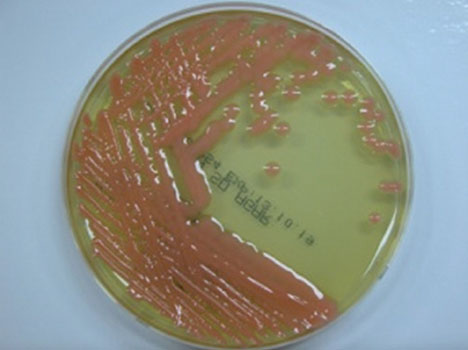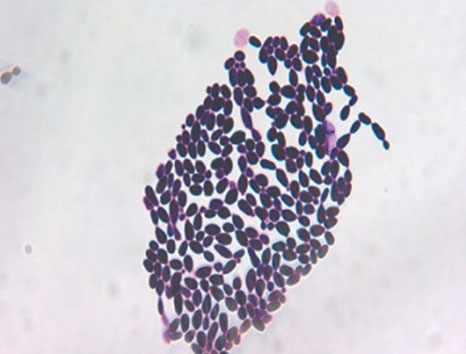Lab Med Online.
2016 Apr;6(2):102-105. 10.3343/lmo.2016.6.2.102.
Sepsis Due to Rhodotorula mucilaginosa in a Patient with Advanced Non-Small Cell Lung Cancer
- Affiliations
-
- 1Department of Laboratory Medicine, Chonbuk National University Medical School, Jeonju, Korea. leehs@jbnu.ac.kr
- 2Chonbuk National University Hospital Branch of National Culture Collection for Pathogens, Jeonju, Korea.
- 3Research Institute of Clinical Medicine of Chonbuk National University-Biomedical Research Institute of Chonbuk National University Hospital, Jeonju, Korea.
- KMID: 2160092
- DOI: http://doi.org/10.3343/lmo.2016.6.2.102
Abstract
- Rhodotorula species are round to oval-shaped, multilateral budding, encapsulated yeasts that produce urease and do not ferment carbohydrates. Rhodotorula species form characteristic salmon-pink colored colonies owing to carotenoid pigment production. These yeasts form a part of the normal flora of moist skin and are found in the environment. Rhodotorula was traditionally considered a contaminant but is now progressively recognized as a human pathogen, especially in immunocompromised patients with central venous catheters. However, isolation of Rhodotorula species from blood has been very rarely reported in Korea. We report a case of sepsis due to Rhodotorula mucilaginosa infection in a patient who had received chemotherapy and supportive care for non-small cell lung cancer.
Keyword
MeSH Terms
Figure
Reference
-
1. El-Tahawy AT, Khalaf RM. Rhodotorula rubra fungemia in an immunocompromised patient. Ann Saudi Med. 1999; 19:533–535.
Article2. Chung JW, Kim BN, Kim YS. Central venous catheter-related Rhodotorula rubra fungemia. J Infect Chemother. 2002; 8:109–110.3. Kim HA, Hyun M, Ryu SY. Catheter-associated Rhodotorula mucilaginosa fungemia in an immunocompetent host. Infect Chemother. 2013; 45:339–342.
Article4. Miceli MH, Diaz JA, Lee SA. Emerging opportunistic yeast infections. Lancet Infect Dis. 2011; 11:142–151.
Article5. Louria DB, Greenberg SM, Molander DW. Fungemia caused by certain nonpathogenic strains of the family Cryptococcaceae. Report of two cases due to Rhodotorula and Torulopsis glabrata. N Engl J Med. 1960; 263:1281–1284.
Article6. De Almeida GM, Costa SF, Melhem M, Motta AL, Szeszs MW, Miyashita F, et al. Rhodotorula spp. isolated from blood cultures: clinical and microbiological aspects. Med Mycol. 2008; 46:547–556.
Article7. Lunardi LW, Aquino VR, Zimerman RA, Goldani LZ. Epidemiology and outcome of Rhodotorula fungemia in a tertiary care hospital. Clin Infect Dis. 2006; 43:e60–e63.8. Wirth F, Goldani LZ. Epidemiology of Rhodotorula: an emerging pathogen. Interdiscip Perspect Infect Dis. 2012; 2012:465717.9. Diekema DJ, Petroelje B, Messer SA, Hollis RJ, Pfaller MA. Activities of available and investigational antifungal agents against Rhodotorula species. J Clin Microbiol. 2005; 43:476–478.
Article10. Zaas AK, Boyce M, Schell W, Lodge BA, Miller JL, Perfect JR. Risk of fungemia due to Rhodotorula and antifungal susceptibility testing of Rhodotorula isolates. J Clin Microbiol. 2003; 41:5233–5235.
Article11. Feldmesser M, Kress Y, Mednick A, Casadevall A. The effect of the echinocandin analogue caspofungin on cell wall glucan synthesis by Cryptococcus neoformans. J Infect Dis. 2000; 182:1791–1795.
Article12. Tuon FF, Costa SF. Rhodotorula infection. A systematic review of 128 cases from literature. Rev Iberoam Micol. 2008; 25:135–140.13. Hsueh PR, Teng LJ, Ho SW, Luh KT. Catheter-related sepsis due to Rhodotorula glutinis. J Clin Microbiol. 2003; 41:857–859.
Article14. Sood S, Nerurkar V. Rhodotorula glutinis fungaemia. Indian Journal of Medical Specialities. 2013; 4:112–114.
- Full Text Links
- Actions
-
Cited
- CITED
-
- Close
- Share
- Similar articles
-
- A Case of Rhodotorula Mucilaginosa Peritonitis undergoing Continuous Ambulatory Peritoneal Dialysis in a Neonate with Acute Renal Failure
- Catheter-Associated Rhodotorula mucilaginosa Fungemia in an Immunocompetent Host
- A Case of Fungemia due to Rhodotorula Glutinis with Liver Cirrhosis
- Management of Locally Advanced Non-small Cell Lung Cancer
- A case of pulmonary mucormycosis complicated by pneumomediastinum and subcutaneous emphysema after chemotherapy in a patient with small cell lung cancer



